After arriving home from my vacation, my eyes searched in the closet for the start of another project ... I would like to build something from WWI, to honor the 100 years of the Great War.
 |
| EMHAR (#4002) MK IV Female WW-I British Heavy Battle Tank A model from Jurassic Era... |
You must be thinking: In a world full of new models and details, as you choose this ancient and crude thing??
Well ... Modeling is fun and hobby. And the end result will be a rare vehicle that does not have in my collection. So, let's have some fun, turning some lemons into lemonade !!!
Well ... Modeling is fun and hobby. And the end result will be a rare vehicle that does not have in my collection. So, let's have some fun, turning some lemons into lemonade !!!
The kit is very, very old but with a decent building...
 |
| The poor Female... |
 |
| The tracks are awful... |
But, first of all, let's know a little about the lineage of this pioneer girl:
 |
| Mark IV tank C14 (No 509 Female). Commanded by 2nd Lt Francis James Arnold. Photographed with German forces after the Battle of Cambrai. |
History:
British heavy tanks were a series of related vehicles developed by the British Army during the First World War. The Mark I was the world's first tank to enter combat.
It was the British Navy - under Winston Churchill, First Lord of the Admiralty - that pushed the "tank" into existence (then known as "landships"). Development of the prototype "Little Willie" tracked armored vehicle gave way...
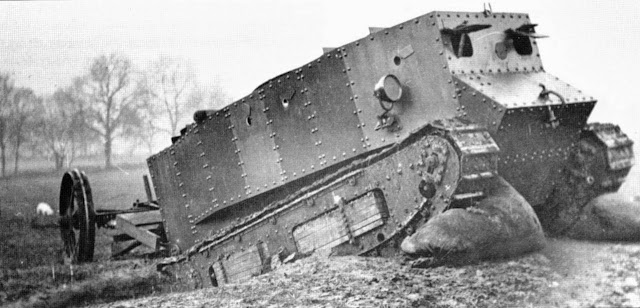 |
| Prototype "Little Willie" |
... to the production level Tank Mk I ("Big Willie") to which 150 of the type were produced and used in the first recorded tank actions of World War 1 in 1916. These tanks showed a typical building design, with tracks involving the entire tank. This type of design became known as rhomboid.
The type brought about limited success for it was prone to breakdowns, vulnerable to artillery fire and managed a snail's pace of roughly 3 to 4 miles per hour - and the latter only on ideal surfaces. Conversely, the vehicle was armed with a pair of cannon, led her crew in relatively safety from small arms fire and could cross trenches of approximately 9 feet across. Its initial use came as a nasty shock to the Germans which allowed the British to gain territory on their historical enemy through psychology alone. Within time, the Germans developed wider trenches, anti-tank ditches, strategically placed artillery and minefields, an anti-tank rifle and armor-piercing machine gun ammunition to stop these steel beasts in their tracks.
The type brought about limited success for it was prone to breakdowns, vulnerable to artillery fire and managed a snail's pace of roughly 3 to 4 miles per hour - and the latter only on ideal surfaces. Conversely, the vehicle was armed with a pair of cannon, led her crew in relatively safety from small arms fire and could cross trenches of approximately 9 feet across. Its initial use came as a nasty shock to the Germans which allowed the British to gain territory on their historical enemy through psychology alone. Within time, the Germans developed wider trenches, anti-tank ditches, strategically placed artillery and minefields, an anti-tank rifle and armor-piercing machine gun ammunition to stop these steel beasts in their tracks.
 |
| A British Mark I "male" tank near Thiepval on 25 September 1916, fitted with wire mesh to deflect grenades and the initial steering tail (shown raised) |
Born of the need to break the domination of trenches, barbed wire and machine guns over the battlefields of the Western Front, it was the first vehicle to be named "tank", a name chosen as an expedient to maintain secrecy and to disguise its true purpose. It was developed to be able to cross trenches, resist small-arms fire, travel over difficult terrain, carry supplies, and to capture fortified enemy positions. It is regarded as successful in many respects, but suffered from many problems owing to its primitive nature.
The Mark I entered service in August 1916, and was first used in action on the morning of 15 September 1916 during the Battle of Flers-Courcelette, part of the Somme Offensive.
The Tank Mk ll was developed from the Tank Mk I was a crew trainer yet even these were pressed into service, some 50 examples being completed and shipped to France. As in the Tank Mk I before it, "Male" variants were the cannon-armed marks...
 |
| Mk IV "Male" tank, armed with cannons |
...while "Female" variants were machine gun-arrned marks intended to protect the Males on their approach. Swinton is credited with inventing the terms.
 |
| Mk IV "Female" tank, armed with machine-guns |
The Tank Mk ll shared much with the Tank Mk I to which the Tank Mk lll was devised as a another more advanced trainer intended to share features of the upcoming Tank Mark lV series.
 |
| Mark II "Male"; tank no. 799 captured by the Germans near Arras on 11 April 1917. |
Reserved for training from the start, the Tank Mk Ill series never saw combat in The Great War and since development of the Tank Mk IV slow in coming, the Tank Mark Ills were slow themselves to appear in a finalized form. As with the Tank Mk ll, there were 50 Tank Mk Ills produced.
With the exception of the few interim Mark II and Mark III tanks, it was followed by the largely similar Mark IV, which first saw combat in June 1917. The Mark IV was used en masse (about 460 tanks) at the Battle of Cambrai in November 1917. The Mark V, with its much improved transmission, entered service in mid-1918.
 |
| Mark V "Male" tank, showing short 6-pounder (57-mm) Hotchkiss gun in right sponson |
The unusual rhomboidal shape was to give as long a track run as possible to allow for crossing the wide trenches prevalent on the Western Front battlefields. Due to the height necessary for this shape, a turreted armament would have made the vehicle too high and top heavy. Instead, the main armament was arranged in sponsons at the side of the vehicle.
The director of the Tank Supply Department, Albert Gerald Stern, first intended to fit the Mark IV with a new engine and transmission. Production of battle tanks was halted until the new design was ready, necessitating the use of the Mark II and III as interim training tanks. Failing to complete development soon enough to start production in time to have 200 tanks ready for the promised date of 1 April 1917, Stern was ultimately forced to take a Mark IV into production in May 1917 that was only slightly different from the Mark I tank.
The Mark IV Male carried three Lewis machine guns – one in the hull front and two in the sponsons, as well as the two sponson guns (now shorter barrelled QF 6 pdr 6 cwt guns). The sponsons were not mirror images of each other, as their configuration differed to allow for the 6 pdr's gun-layer operating his gun from the left and the loader serving the gun from the right. The guns had a 100 degree arc of fire but only the starboard gun could fire straight ahead. The Female had five machine guns. Two of the machine guns were operated by the gun loaders.
The decision to standardize on the Lewis gun was due to the space available within the tanks. Despite its vulnerable barrel and a tendency to overheat or foul after prolonged firing, the Lewis used compact drum magazines which could hold up to 96 rounds. The Hotchkiss was fed from a rigid strip which was trimmed down to only 14 rounds for tank use; no sooner had the machine gunner guided the fall of shot onto the target then it was time to change the strip and the process repeated. It was not until a flexible 50 round strip was fully developed in May 1917 that the Hotchkiss would become the standard machine gun for tanks again. The changes caused delays, such as adapting the design for the bulky Lewis cooling barrel, and later, problems when the Hotchkiss strips had to be stored in positions designed for Lewis gun magazines.
This tank introduced the use of the fascine, a bundle of brushwood, bound with chains, about 3.0 m long and 1.4 m in diameter carried on the front. It was dropped into trenches to allow the tank to more easily cross over.
 |
| Mk IV Females with fascines |
And also there were wooden structures with metal reinforcements that performed the same function of fascines: the crib.
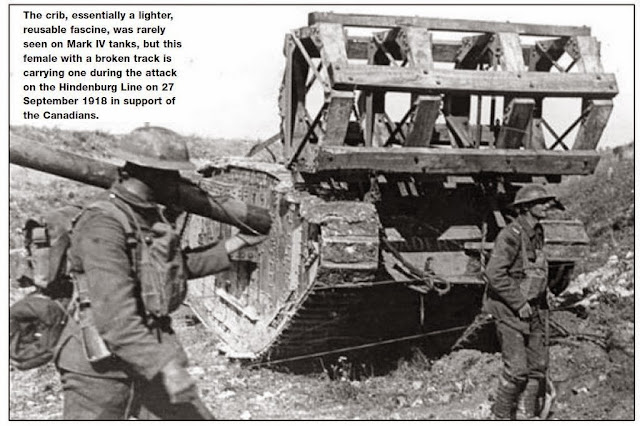 |
| Mk IV Female with crib |
A large number of these tanks were also used for development work. In an attempt to improve trench-crossing capability one alternative was to stretch the tank, although this would raise problems connected with steering. Fosters-Daimler came up with a device known as the ‘Tadpole Tail’, which extended the track frames rearwards but, most of the time at least, remained clear of the ground.
 |
| Side view of Mk IV Male Tadpole. Notice the outline of a common Mk IV Male in white |
The attachment lengthened the tank by 2.74m and required 28 more track plates on each side and an extension of the chain drive to the rear sprocket. As is often the case, the modified tank worked adequately on trials but did not stand up so well to continued use, the tail being too light and flexible to remain rigid enough.
 |
Tadpole in trials, negotiating a trench crossing... |
A substantial number of these tails were made and shipped to France, but there is no evidence to suggest that they were employed on service tanks. The original modified Mark IV, a Male machine, was used for various trials,including sledge-towing and the mounting of a Newton mortar in the gap between the rear frames and set to fire forwards, over the tank.
 |
| A Mk IV Male Tadpole in sledge-towing trials |
 |
| Tadpole Tail Mark IV was later fitted with a 6-in. Newton trench mortar between the rear horns to experiment with close support for tanks in the attack. |
The Tadpole Tail was also fitted experimentally to the Mark V tank, but it does not appear to have been popular with Central Workshops personnel in France, who came up with a solution of their own.
The main defect of the device was lacked rigidity and therefore was dropped in favour of extending the main hull of the tank, as was done in the Mark V*. The Tadpole not appear to have been used in combat.
 |
| A Tadpole in the mud, happy in his ambience... |
 |
| Mk I heavy tank testing aerials for wireless |
 |
| Mk IV Female airship tug |
 |
| Mk IV Female with crane |
 |
| Mk IV Supply with crane |
Some of these devices were later used on operational tanks. Mark IVs were also the first tanks fitted with unditching beams by field workshops. A large wooden beam, reinforced with sheet metal, was stored across the top of the tank on a set of parallel rails. If the tank became stuck, the beam was attached to the tracks (often under fire) and then dragged beneath the vehicle, providing grip.
 |
| Mk IV Male with unditching wooden beam |
The Mark IV was built by six manufacturers: Metropolitan (the majority builder), Fosters of Lincoln, Armstrong-Whitworth, Coventry Ordnance Works, William Beardmore and Company and Mirrlees, Watson & Co., with the main production being in 1917. The first order was placed for 1,000 tanks with Metropolitan in August 1916. It was then cancelled, reinstated and then modified between August and December 1916. The other manufacturers, contracted for no more than 100 tanks each, were largely immune to the conflict between Stern and the War Office.
In the end of WWI, many Mark IVs (preferably the Males), now considered obsolete, were converted to supply tanks, having their armament removed and apertures closed. Others were factory built, for a total of around 205 such units.
 |
| Mk IV Male 'Supply' supply tank variant going up to the line at Villers-Bretonneux, August 1918 |
Service:
The Mark IV was first used in large numbers on 7 June 1917, during the British assault on Messines Ridge. Crossing dry but heavily cratered terrain, many of the sixty-plus Mark IVs lagged behind the infantry, but several made important contributions to the battle. By comparison, at the Third Battle of Ypres (also known as Passchendaele) from 31 July, where the preliminary 24-day long barrage had destroyed all drainage and heavy rain had soaked the field, the tanks found it heavy going and contributed little; those that sank into the swampy ground were immobilized and became easy targets for enemy artillery.
Nearly 460 Mark IV tanks were used during the Battle of Cambrai in November 1917, showing that a large concentration of tanks could quickly overcome even the most sophisticated trench systems.
In the aftermath of the German Spring Offensive on the western front, the first tank-to-tank battle was between Mk IV tanks and German A7Vs in the Second Battle of Villers-Bretonneux in April 1918.
 |
| Stürmpanzerwagen A7V "Wodan" |
About 40 captured Mark IVs were employed by the Germans as Beutepanzerwagen (The German word Beute means "loot" or "booty") with a crew of twelve. These formed four tank companies from December 1917. Some of these had their six pounders replaced by a German equivalent.
 |
| Mk IV Male Beutepanzerwagen |
 |
| Mk IV Female Beutepanzerwagen |
The last Mark IV to see service was Excellent, a Mark IV male retained by the naval gunnery school on Whale Island, HMS Excellent. In the early years of the Second World War it was restored to operational status and driven to the mainland, where its new career was allegedly brought to an early end after a number of cars were damaged.
Comparison of World War I tanks
Comparison of World War I tanks
| Tank | Country | Year | Prod. total | Crew | Armament number of rounds | Armour (front/ side/top) | Weight (tonnes) | Engine | power/ weight ratio | Speed (km/h) | Range |
|---|---|---|---|---|---|---|---|---|---|---|---|
| Mark I Male | UK | 1916 | 75 | 8 | 2×6 pounder (57 mm/L40) [324], 3×MG [6,272] | 12/10/6 mm | 28.4 t | Petrol 105 hp (78 kW) | 3.7 hp/t | 4.5 km/h | 37 km |
| Female | 75 | 5×MG [30,080] | 27.4 t | ||||||||
| Mark IV Male | UK | 1917 | 420 | 8 | 2×57 mm/L23 [332], 3×MG [6,272] | 14/12/8 mm | 28.5 t | 125 hp (93 kW) | 5.6 km/h | 56 km | |
| Female | 595 | 5×MG [10,000] | 27 t | ||||||||
| Mark V Male | UK | 1918 | 200 | 8 | 2×57 mm/L23 [207], 4×MG [5,800] | 14/14/8 mm | 29.5 t | 150 hp (112 kW) | 5.1 hp/t | 7.5 km/h | 72 km |
| Female | 200 | 6×.303 MG [14,100] | 28.5 t | ||||||||
| Mark V* Male | UK | 1918 | 200 | 8+24 infantry | 2×57 mm/L23 [221], 8×MG [8,400] | 14/12/6 mm | 33 t | 4 km/h | 63 km | ||
| Female | 432 | 10×MG [16,800] | 32 t | ||||||||
| Medium Mark A Whippet | UK | 1918 | 200 | 3-4 | 4×.303 MG [5,400] | 14/14/5 mm | 14 t | Petrol 2×45 hp (34 kW) | 6.4 hp/t | 13 km/h | 64 km |
| Schneider CA1 | France | 1917 | 400 | 6 | 75 mm/L13 [94–96], 2× 7.92 mm MG [3,840] | 11.5/11.5/5.5 mm | 13.5 t | 60 hp (45 kW) | 8 km/h | 48 km | |
| 1917 | 24/17/5.5 mm | 14.6 t | 75 km | ||||||||
| Saint-Chamond | France | 1917 | 165 | 8 | 75 mm/? [106–108], 4× 7.92 mm MG [7,488] | 11.5/8.5/5.5 mm | 22 t | 90 hp (67 kW) | 4.1 hp/t | 12 km/h | 60 km |
| Saint-Chamond | 1917 | 235 | 75 mm/L36 [106–108], 4× 7.92 mm MG [7,488] | 19.5/17/5.5 mm | 24 t | ||||||
| Renault FT mitrailleuse | France | 1918 | 3,694 | 2 | 7.92 mm MG [4,800] | 16/8/6 mm | 6.5 t | 35 hp (26 kW) | 10.7 hp/t | 8 km/h | 35 km |
| Renault FT canon | 1918 | 37 mm/L20 [240] | 6.7 t | ||||||||
| A7V | Germany | 1918 | 20 | 18 | 57 mm/L26 [180], 6×MG [10,000–15,000] | 30/20/10 mm | 32 t | 2×100 hp (75 kW) | 6.25 hp/t | 12 km/h | 35 km |
Mk IV videos:
Surviving vehicles:
Seven Mark IVs survive.
- A Mark IV Female, F4: Flirt II, which fought at the Battle of Cambrai, is at the Museum of Lincolnshire Life, Lincoln.A local company, William Foster & Co., manufactured the first tanks, although as the only Mark IVs built in Lincoln were Male, Flirt was probably built by Metropolitan in Birmingham.
- A Mark IV Female is preserved at Ashford in Kent. This is one of many that were presented for display to towns and cities in Britain after the war; most were scrapped in the 1920s and 1930s. Interestingly this tank appears to sit on a box. This is in fact blocking a hole under the tank which was cut out to remove the engine in order to install an electricity substation inside it. This was then removed a decade or so later to leave a hollow interior.
- The Royal Museum of the Army in Brussels has a Male Mark IV tank, the Lodestar III, still in original colours.
- A Mark IV Female, Grit, is owned by the Australian War Memorial and annually goes on display at their open day.
- In 1999, a Mark IV Female, D51: Deborah, was excavated at the village of Flesquières in France. It had been knocked out by shell-fire at the Battle of Cambrai (1917) and subsequently buried when used to fill a crater. Work is underway on its restoration.
- A Mark IV Male, Excellent, is displayed at Bovington. After World War I, this tank was presented by the army to HMS Excellent, a Royal Navy shore establishment where some tank crewmen were trained. During World War II, it was made operational again for service with the Home Guard when German invasion threatened in 1940. It is still maintained in working order.
- Mark IV Female Liberty: displayed at United States Army Ordnance Museum, Aberdeen, Maryland. Originally named Britannia, this tank took part in the Battle of Arras where it penetrated the German trench lines, destroyed four machine gun positions, helped take 395 prisoners and repulse two German counter-attacks. The tank and her crew were afterwards sent to the US to help sell War bonds. Renamed Liberty, the tank joined the Ordnance Museum collection in 1919. After decades of exposure to the elements it is in poor condition, but about to undergo restoration.
Specs:
| Mark IV heavy tank | |
|---|---|
Place of origin Type
|
Tank
|
Service history
| |
Used by
| |
Wars
| |
Production history
| |
Designer
|
Major Walter Gordon Wilson
|
Manufacturer
|
see text
|
Unit cost
|
about £5,000
|
Produced
|
May 1917 – end 1918
|
Number built
|
1,220
|
Specifications
| |
Weight
|
Male: 29 tons (28.4 tonnes)
Female: 27 tons (27.4 tonnes)
|
Length
|
Male and Female: 8.05 m
Tadpole: 10.80 m
|
Width
Height
|
Male: 4.12 m
Female: 4.06 m
All: 2.49 m
|
Crew
|
8
|
6.1–12 mm
| |
Main
armament
|
Male: Two 6-pounder (57-mm) 6 cwt QF guns with 332 rounds
Female: five .303 Lewis guns
|
Secondary
armament
|
Male: Three .303 in Lewis guns
Female: none
Tadpole: 152,4mm (6inch) mortar
|
Engine
|
Daimler-Foster, 6-cylinder in-linesleeve valve 16 litre petrol engine
105 bhp at 1,000 rpm
|
Transmission
|
Primary: 2 Forward, 1 Reverse
Secondary – 2 speed
|
Fuel capacity
|
319 liters
|
Operational
range
|
56 km
|
Speed
|
6.4 km/h
|
The kit:
As my kit is a scrap, I'll do something rare ...an airship tug:
 |
| Mk IV Female 261 airship tug - left side Notice the absence of the guns |
 |
| Mk IV Female 261 airship tug - rear view |
 |
| The Mk IV Female 261 with his customer, the Airship 23, in 1918 |
Made me want to build the Airship 23 in scale, but a blimp of 163.00 m in length in 1/35 scale, it would be a cylinder of 4.65 m. It would be a very cool diorama, but ...Infeasible ... Sorry !!!
 |
| Airship 23, first of the 23 Class |
 |
| Painting of two 23-class airships at Pulham by John Lavery. Note the Mk IV Female tank 261 (without tower) in the foreground used for ground-handling. |
 |
| The tank and the airship in scale....What a diorama... |
I removed the MGs and reinstall the tracks: Notice the Mk IV Male in background. I built this EMHAR kit a long time ago...
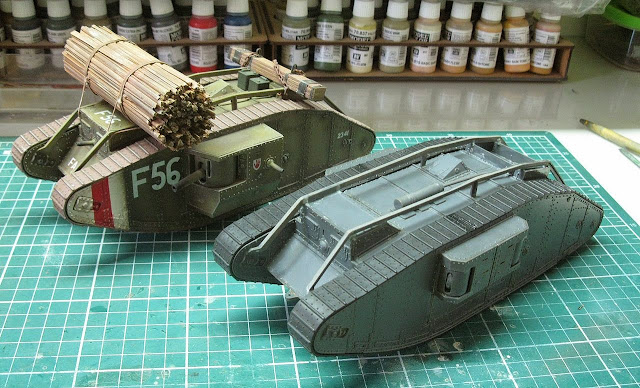 |
| Mk IV Male and Female . Notice the fascine, made with bamboo slivers |
I convert the blueprint in 1/35 scale in Corel Draw and start the building: Tower tug...
 |
| Building the vertical beams of the tower - left side |
 |
| The Plastruct used in the tower |
 |
| The horizontal structural reinforcements |
 |
| The horizontal structural reinforcements and front and rear raisers |
 |
| Finally, the diagonal ribs |
 |
| Almost there .... |
 |
| The mooring system for the airship |
 |
| Rear tow bar and crank of the mooring system |
Painting time: As the tank was added at a Navy Station (It was the Royal Navy who controlled the R23 airships), I decided to paint the girl in Gray-Navy:
 |
| The Mk IV Female airship tug in Navy-Gray |
 |
| I improved the exhaust pipe with a copper tube ( air conditioning scrap) |
 |
| Tracks and exhaust in red-oxide... My intention is to coat the exhaust with asbestos (Tamiya tape) |
Markings for Mk IV Female tug: One frustrating thing is you can not print blank. The solution was to print the decal in yellow and paint with white over ....The White-261 was born...
 |
| Panzerserra's decals...right side |
 |
| Front view |
At this stage, I decided to build a Mk IV Male Tadpole together with airship Female tug, to save time:
My inspiration of colors:
 |
| The EMHAR Tadpole kit. |
 |
| The Female airship tug with Tadpole booklet |
 |
| Kit parts... |
 |
| Decreasing the diameter of the idler wheels with Dremel and scalp... |
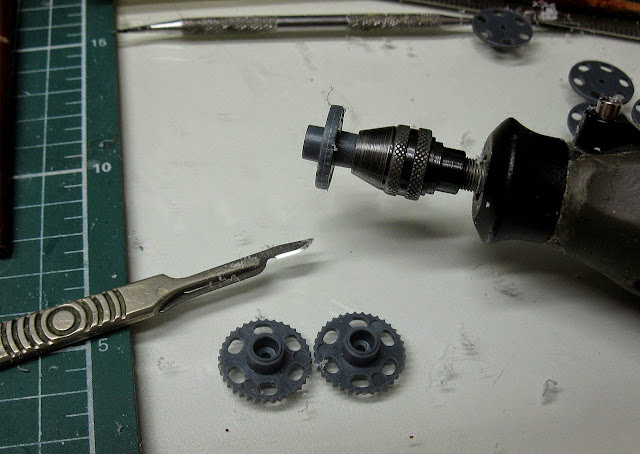 |
| and reducing the diameter of the drive sprockets. This facilitates the fitting of tracks |
 |
| From the bottom to the front: Mk IV Male gun tank, Mk IV Female airship tug and Mk IV Male Tadpole |
 |
| The Tadpole almost complete... |
But, returning to the Female, it is time to turn the yellow decal in white.
 |
| After a layer of white paint, applied with steady hand and brush ... |
 |
| Front view |
 |
| Notice the "asbestos" in the exhaust pipe... |
 |
| Rear view of Female airship tug White-261 |
Lads, this is the final step:
Finally:
Mk IV Male Tadpole Protitype with mortar - 1918
 |
| The Tadpole, with White markings - left side |
 |
| Tadpole, with White markings - right side |
Adding details (great ...) from Value Gear:
 |
| Very, very good stuff from Value Gear |
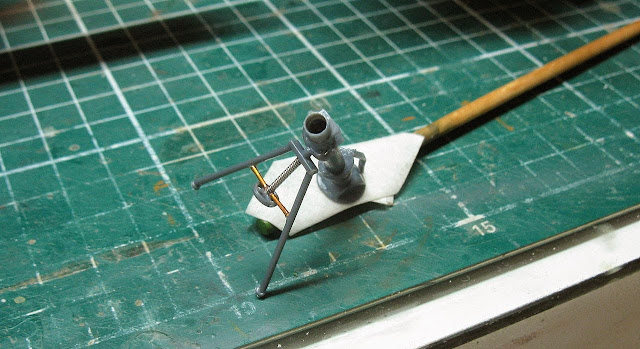 |
| The EMHAR 6' mortar, with some details in scratch |
 |
| Gun-metal... |
 |
| And almost there ... |
Mk IV Male Tadpole Protitype with mortar - 1918
 |
| Mk IV Male Tadpole prototype with mortar - 1918 |
 |
| Mk IV Male Tadpole - left side |
 |
| Mk IV Male Tadpole - the mortar between the rear horns |
 |
| Mk IV Male Tadpole - cargo |
 |
| Mk IV Male Tadpole - right side |
 |
| Mk IV Male Tadpole with Kojak and Rover, the dog. |
Mk IV Male FANTAN (case report- I built this beast a long, long time ago...): The kit represents the Mark IV Male F-56 FANTAN - 2341, from 12th Section - 18th Company - F Battalion, in the Battle of Cambrai, November - 1917
 |
| Mark IV Male F-56 FANTAN - 2341 12th Section - 18th Company - F Battalion Battle of Cambrai, November - 1917 |
 |
| Mark IV Male F-56 FANTAN - left side |
 |
| The fascine and unditching wooden beam are in scartch |
 |
| Mark IV Male F-56 FANTAN - right side |
 |
| Two Mks IV Males: Tadpole and Gun tank |
 |
| Notice the sizes... |
 |
| Mark IV Male F-56 FANTAN with Kojak and Rover, the dog... |
And, finally, the Mk IV Female Airship tug "White-261". Royal Naval Air Station, Pulhan, Norfolk, 1918. Here, I added a small accessory that I think would be useful for anchoring and handling of a airship: a windsock. No photographic evidence of this use, but I think it would be logical and useful.
 |
| Mk IV Female Airship tug with windsock. Maybe... |
 |
| Mk IV Female Airship tug "White-261". Royal Naval Air Station, Pulhan, Norfolk, 1918. |
 |
| Mk IV Female Airship tug "White-261" - left side |
 |
| Mk IV Female Airship tug "White-261" - right side |
 |
| Mk IV Female Airship tug "White-261" with mooring ropes |
 |
| Value Gear stuff... |
 |
| Mk IV Female Airship tug "White-261" with Kojak and Rover, the dog. |
 |
| Mk IV Male Tadpole and Mk IV Female Airship tug "White-261" |
 |
| Two oddballs; Tadpole and M4A3E8 (75) W pic for size comparison |
 |
| Two rare girls... |
Well, Gents...There this !!!
It's a long way !!!

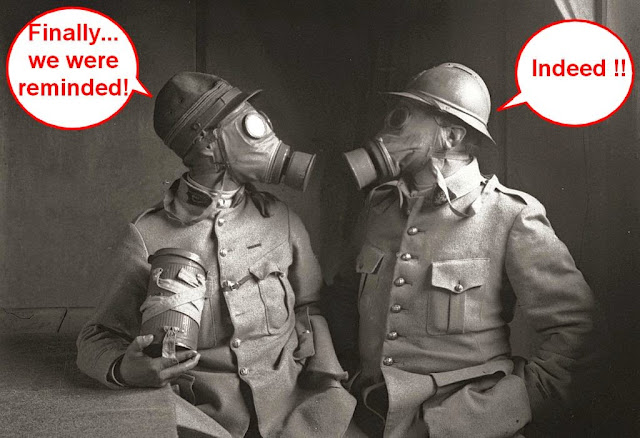


























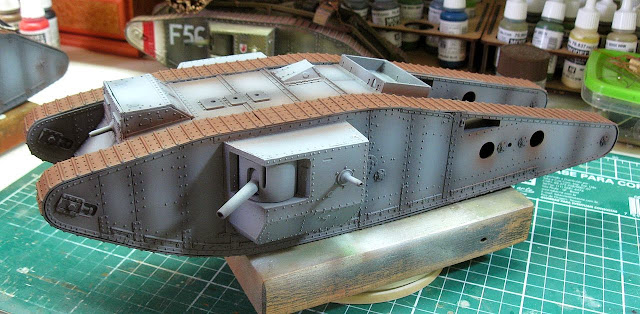

























Nice job, and great looking pics!
ResponderExcluirHi, Phil... Thanks for the incentive...Stay alert, my friend...
ResponderExcluirBig hug !!!
Yes this case it's a really a girl (a female in fact !) and I suppose the male will follow after.
ResponderExcluirGood idea to honoring the fighters of the "Grea War". Happy miodeling.
Very nice intro and beautiful photos
ResponderExcluir@Alain: Yes...I'll try to build some beauties of WWI as a tribute: On the list, a Hermaphrodite and a Tadpole. The Male I built many years ago and I will show such as case report. Take care !!!
ResponderExcluir@Danny: Thanks, Man...stay alert for the next steps...Hugs !!!
Hi, Doctor!
ResponderExcluir"Nephew" here...:o)...
That's a nice project...very different and will give you chance to work in the structure...nice!...:o)...
I'll keep checking out the progress!
Hope I'll see you here visiting us soon!
Edilson
Hi, Edilson...I'll use the Plastructs, for this project !!!
ResponderExcluirThe best investment, ever !!! and about the visit, is the next on the list !!!!
Big hug, Nephew ..all the best to you and your beautiful family !!!
E vamos potixar ...
Hello a long period of time.
ResponderExcluirYou have once again found new, and very interesting direction.
I mean the construction and of course an extensive history report, met with that.